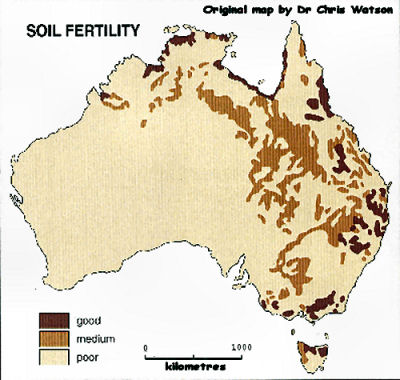 To keep up with global food demand, the UN estimates, six million ha of new farmland will be needed every year. Instead, 12 million ha are lost every year through soil degradation. Australia lost 36 million ha of agricultural land in just the four years from 2005 till 2009. Some of this lost land has occurred because of urban sprawl which is swallowing up some of our best soils close to cities that used to supply the fresh fruit and vegetables. A scathing report by the Royal Commission has gone as far to accuse the Murray-Darling Basin Authority (MDBA) of negligence and being "incapable of acting lawfully," apparently because they overestimated the amount of water returned to the river by a factor of ten. The many warning signs all around us are continually ignored by politicians obsessed with economic theories that defy even the basic laws of mathematics.
To keep up with global food demand, the UN estimates, six million ha of new farmland will be needed every year. Instead, 12 million ha are lost every year through soil degradation. Australia lost 36 million ha of agricultural land in just the four years from 2005 till 2009. Some of this lost land has occurred because of urban sprawl which is swallowing up some of our best soils close to cities that used to supply the fresh fruit and vegetables. A scathing report by the Royal Commission has gone as far to accuse the Murray-Darling Basin Authority (MDBA) of negligence and being "incapable of acting lawfully," apparently because they overestimated the amount of water returned to the river by a factor of ten. The many warning signs all around us are continually ignored by politicians obsessed with economic theories that defy even the basic laws of mathematics.

Australia is mostly a big desert
Australia is the sixth largest country in the world and also the driest inhabited continent on earth, with the least amount of water in rivers, the lowest run-off and the smallest area of permanent wetlands of all the continents.
Its ocean territory is the world's third largest, spanning three oceans and covering around 12 million square kilometers.
One third of the continent produces almost no run-off at all and Australia's rainfall and stream-flow are the most variable in the world.
Soil
Australia also has some of the oldest land surface on earth and, while rich in biodiversity, its soils and seas are among the most nutrient poor and unproductive in the world. This is due mainly to the country's geological stability, which is a major feature of the Australian land mass, and is characterized by, among other things, a lack of significant seismic activity.
Only six per cent of the Australian landmass is arable. As a result, agricultural yields are low compared to other nations: German farms produce over nine metric tonnes/ha compared to Australia's two tonnes.

Australian soils are highly dependent upon vegetation cover and insect biomass to generate nutrients and prevent erosion. It is the native vegetation's long root systems that help break down the sub soil and bring nutrients to the surface, while insects, bacteria, and small animals, reduce ground litter and add nitrogen.
Land clearing, water extraction and poor soil conservation are all causes of a decline in the quality of Australia's soils, now the collapse of insect populations adds another blow. [1]
What causes land-degradation in Australia
The two most significant direct causes of land degradation are the conversion of native vegetation into crop and grazing lands, and unsustainable land-management practices.
Other factors include the effects of climate change and loss of land to urbanization, infrastructure and mining.
However, the underlying driver of all these changes is rising demand from growing populations for food, meat and grains, as well as fibre and energy. This in turn leads to more demand for land and further encroachment into areas with marginal soils.
Market deregulation, which has been a trend since the 1980s, can lead to the destruction of sustainable land management practices in favor of monocultures and can encourage a race to the bottom as far as environmental protection is concerned. The 2016 State of the Environment report noted that:
”Current rates of soil erosion by water across much of Australia now exceed soil formation rates by an order of magnitude or more. As a result, the expected half-life of soils (the time for half the soil to be eroded) in some upland areas used for agriculture has declined to merely decades.”
Our soils are losing their fertility
The carbon content of Australian soils, which is a measure of fertility, is now some five to 10 times lower than when measured in 1845. The UN has warned that there could be as little as 60 harvests remaining before the world's soils in places like Australia reach the limits of agricultural production.
To keep up with global food demand, the UN estimates, six million ha of new farmland will be needed every year. Instead, 12 million ha are lost every year through soil degradation. Australia lost 36 million ha of agricultural land in just the four years from 2005 till 2009. Some of this lost land has occurred because of urban sprawl which is swallowing up some of our best soils close to cities that used to supply the fresh fruit and vegetables.[2]
Despite this, agricultural products accounted for 15 per cent of Australia’s total exports in 2015-16, and the gross value of farm production was more than $63 billion largely because we currently have around two ha of arable land per person, one of the highest rates in the world.
Murray Darling Basin

However 40% of that production came from the Murray Darling irrigation area which had high production based on historic over-allocation of water, something that has now come back to bite us. A scathing report by the Royal Commission has gone as far to accuse the Murray-Darling Basin Authority (MDBA) of negligence and being "incapable of acting lawfully," apparently because they overestimated the amount of water returned to the river by a factor of ten.
Groundwater
With our highly variable surface water supply, groundwater resources are critical for many Australian communities and industries. In some cases, groundwater is the only reliable water supply available to support towns, agriculture and the resources sector. Australia is a very dry country so groundwater is extensively used right across the continent.
Perth relies heavily on the Gnangara Mound aquifer for its water supply, but the water table has been dropping for the past 40 years or more because of reduced rainfall, increased extraction, and decreased recharge.
The Great Artesian Basin, underlying about 1.7 million square kilometres of Australia, contains about 65,000 km3 of water, but it is a “Fossil water”, being up to 2 million years old, so extraction is far faster than replenishment.
It is not widely understood that vegetation and many streams and rivers are supported by the availability of groundwater, either as discharge into streams and rivers or through groundwater uptake by plant roots directly.
In the Northern Territory, Palm Valley has an average rainfall of only 200mm, but spring fed pools allow its unique flora to survive. The same applies for the Doongmabulla Springs Complex, a one-square-kilometre expanse of nationally important wetlands near the proposed site of the Carmichael coal mine in Queensland, which would probably be destroyed if Adani is allowed to extract the water it needs.
As the pressure in the Great Artesian Basin has declined and the water table drops, mound springs (where groundwater is pushed to the ground surface under pressure) have begun to dry up in South Australia and Queensland.
Associated paperbark swamps and wetlands are also being lost and it gets more and more expensive to extract the groundwater for irrigation and other commercial applications. On average, rates of groundwater extraction across Australia have increased by about 100 per cent between the early 1980s and the early 2000s, reflecting both our increased population size and the associated commercial usage of groundwater stores.

We are also putting these resources at risk from pollution. Already there have been many incidences of ground water being polluted by petroleum products, chemicals, fertilizers, pesticides, salt and even nuclear waste. However the main aquifers are being put at risk from fracking, acid leaching of minerals like uranium and underground coal gasification.
Converting the aquifer’s recharge area into farmland is likely to increase the level of nitrogen compounds while the large blasting used in open cut mining is fracturing rock formations deep underground, allowing contamination of water from above or intermingling with salty water.
Growth economics deaf to reason
All of which explains why scientists have been warning us for years that we cannot continue to grow without doing great damage to our fragile nation, but they are continually ignored by politicians obsessed with economic theories that defy even the basic laws of mathematics.
and......
Underground Coal Gasification was trialed and was proved to have failed in three sites in Queensland with the operator gas company Linc Energy charged with five counts of wilful and unlawful environmental harm. They faced penalties of up to $9 million but were declared bankrupt, leaving the Qld government with a clean up bill of $80m.
Despite this, a similar plant at Leigh creek has been given the green light after a failed challenged by the Adnyamathanha people in the Supreme Court of South Australia. The chairman of Leigh Creek energy claimed that Linc energy was a great company and that there was no environmental damage. Well he would have to say that since he was also chairman of Linc before they went broke.
 Humans have a magnificent brain, one that even while at rest churns through more information in 30 seconds than the Hubble space telescope has processed in thirty years. In fact the brain absorbs so much data it also has to decide which is relevant and which to ignore, a feature that makes us terrible witnesses.
Humans have a magnificent brain, one that even while at rest churns through more information in 30 seconds than the Hubble space telescope has processed in thirty years. In fact the brain absorbs so much data it also has to decide which is relevant and which to ignore, a feature that makes us terrible witnesses.
 Don Owers humorously points out the not-so-funny posturing in the Climate Council's loud criticism of Sky News and News Corp regarding disinformation on climate change, in the face of its own strange silence - dare we say collusion? - about the principal drivers of carbon emission growth in Australia, namely government and lobby-group-engineered population and intensive development growth.
Don Owers humorously points out the not-so-funny posturing in the Climate Council's loud criticism of Sky News and News Corp regarding disinformation on climate change, in the face of its own strange silence - dare we say collusion? - about the principal drivers of carbon emission growth in Australia, namely government and lobby-group-engineered population and intensive development growth. Recently the right-wing governor of Texas, who just happens to be named Abbott, announced that the state will install a barrier made of buoys along a section of the Rio Grande to deter migrants from entering the US. As is so often the case his measures, which also included a commitment to spend $5.1b on other border security measures, was met with howls of indignation by immigration advocates who argued that this deprives migrants of the right to seek asylum from persecution. Those supporti
Recently the right-wing governor of Texas, who just happens to be named Abbott, announced that the state will install a barrier made of buoys along a section of the Rio Grande to deter migrants from entering the US. As is so often the case his measures, which also included a commitment to spend $5.1b on other border security measures, was met with howls of indignation by immigration advocates who argued that this deprives migrants of the right to seek asylum from persecution. Those supporti The 100 years from 1870 is described as the innovation century in which there more more inventions, starting coincidentally with the light bulb, than in the rest of mankind's history. For the most part their roll out into society was slow enough to dampen the impact of the invention, electricity wasn't connected fully in Australia until 1989. But for me there was one event that stood out and that occurred on on the 4th of October 1957 just before my birthday.
The 100 years from 1870 is described as the innovation century in which there more more inventions, starting coincidentally with the light bulb, than in the rest of mankind's history. For the most part their roll out into society was slow enough to dampen the impact of the invention, electricity wasn't connected fully in Australia until 1989. But for me there was one event that stood out and that occurred on on the 4th of October 1957 just before my birthday.
 Recently the South Australian premier called for higher immigration in his water-scarce state. This was followed by a similar plea from the Northern Territory government, which is seeking more workers, and is
Recently the South Australian premier called for higher immigration in his water-scarce state. This was followed by a similar plea from the Northern Territory government, which is seeking more workers, and is 
 Australia's high density buildings are not designed to mitigate the spread of a virus as they have poor air circulation, insufficient balconies, and are usually designed for people who are away all day and only home to sleep. Our cities do not have enough open space areas for residents in high density apartments to escape to, yet we are still inundated with business and media statements extolling the benefits of population growth that can be accommodated in ever higher densitie
Australia's high density buildings are not designed to mitigate the spread of a virus as they have poor air circulation, insufficient balconies, and are usually designed for people who are away all day and only home to sleep. Our cities do not have enough open space areas for residents in high density apartments to escape to, yet we are still inundated with business and media statements extolling the benefits of population growth that can be accommodated in ever higher densitie
 New "Teal" politician and economic growthist,
New "Teal" politician and economic growthist,  The Sydney Morning Herald of June 4th this year reported that Kristina Keneally, labor's Shadow Minister for Home Affairs, would advocate the economic importance of immigration - a sign the Opposition is willing to make the case for a bigger Australia as it considers its post-election policy platform. It would be a policy that was against the wishes of a majority of Australians and would be destructive economically, environmentally and socially.
The Sydney Morning Herald of June 4th this year reported that Kristina Keneally, labor's Shadow Minister for Home Affairs, would advocate the economic importance of immigration - a sign the Opposition is willing to make the case for a bigger Australia as it considers its post-election policy platform. It would be a policy that was against the wishes of a majority of Australians and would be destructive economically, environmentally and socially.
 There is an accepted truism that when it comes to politics what appears to be a conspiracy is usually just the result of poor government decisions. It is a logical conclusion given that conspiracies require clever conspirators and politicians are generally not seen as being clever. This of course is not correct, its a belief acquired because politicians are continually criticized by the media and even more so by their colleagues.
There is an accepted truism that when it comes to politics what appears to be a conspiracy is usually just the result of poor government decisions. It is a logical conclusion given that conspiracies require clever conspirators and politicians are generally not seen as being clever. This of course is not correct, its a belief acquired because politicians are continually criticized by the media and even more so by their colleagues. 
 To keep up with global food demand, the UN estimates, six million ha of new farmland will be needed every year. Instead, 12 million ha are lost every year through soil degradation. Australia lost 36 million ha of agricultural land in just the four years from 2005 till 2009. Some of this lost land has occurred because of urban sprawl which is swallowing up some of our best soils close to cities that used to supply the fresh fruit and vegetables. A scathing report by the Royal Commission has gone as far to accuse the Murray-Darling Basin Authority (MDBA) of negligence and being "incapable of acting lawfully," apparently because they overestimated the amount of water returned to the river by a factor of ten. The many warning signs all around us are continually ignored by politicians obsessed with economic theories that defy even the basic laws of mathematics.
To keep up with global food demand, the UN estimates, six million ha of new farmland will be needed every year. Instead, 12 million ha are lost every year through soil degradation. Australia lost 36 million ha of agricultural land in just the four years from 2005 till 2009. Some of this lost land has occurred because of urban sprawl which is swallowing up some of our best soils close to cities that used to supply the fresh fruit and vegetables. A scathing report by the Royal Commission has gone as far to accuse the Murray-Darling Basin Authority (MDBA) of negligence and being "incapable of acting lawfully," apparently because they overestimated the amount of water returned to the river by a factor of ten. The many warning signs all around us are continually ignored by politicians obsessed with economic theories that defy even the basic laws of mathematics.



 This article provides a quick analysis of the 128 page document, Creating Liveable Cities in Australia. Although it does not provide a complete picture, it finds many obvious flaws which suggest that it should not be accepted at its face value.
This article provides a quick analysis of the 128 page document, Creating Liveable Cities in Australia. Although it does not provide a complete picture, it finds many obvious flaws which suggest that it should not be accepted at its face value. You probably would have noticed the media attention given to the Australian economies historic 26 year reign of economic growth which has been claimed is breaking that held by the Netherlands. Apart from being incorrect, (The Netherlands’ real GDP declined by 0.3% in the June quarter of 2003, and by 0.01% in the September quarter of that year) that record should go to Japan. In fact, if Japanese GDP data were available on a quarterly basis earlier than 1960, it’s likely that this run of continuous economic growth would have been even longer, perhaps as long as 38 years, inferring from annual data available back to 1955. Not bad for a nation mocked for its decision to abandon population growth and actually reduce its population.
You probably would have noticed the media attention given to the Australian economies historic 26 year reign of economic growth which has been claimed is breaking that held by the Netherlands. Apart from being incorrect, (The Netherlands’ real GDP declined by 0.3% in the June quarter of 2003, and by 0.01% in the September quarter of that year) that record should go to Japan. In fact, if Japanese GDP data were available on a quarterly basis earlier than 1960, it’s likely that this run of continuous economic growth would have been even longer, perhaps as long as 38 years, inferring from annual data available back to 1955. Not bad for a nation mocked for its decision to abandon population growth and actually reduce its population. Australia may have the world’s highest debt to GDP ratio. We have the lowest ranking in the region (61st) for income security. Our social expenditure is behind Greece, Portugal, Spain and Italy's. The OECD has ranked Australia second last in government funding of public education.
Australia may have the world’s highest debt to GDP ratio. We have the lowest ranking in the region (61st) for income security. Our social expenditure is behind Greece, Portugal, Spain and Italy's. The OECD has ranked Australia second last in government funding of public education. The treasurer, Scott Morrison, has just informed us that we have had 25 years of economic growth and the economy is now growing at its fastest pace in four years, meaning we may well set a new record for the longest period of sustained growth.
The treasurer, Scott Morrison, has just informed us that we have had 25 years of economic growth and the economy is now growing at its fastest pace in four years, meaning we may well set a new record for the longest period of sustained growth. 

Recent comments